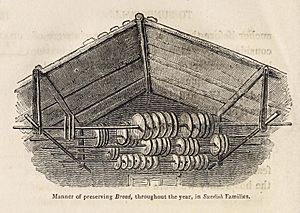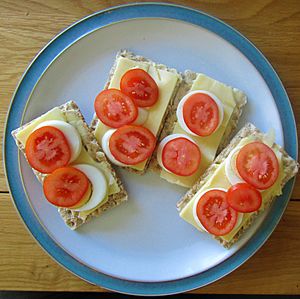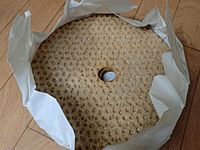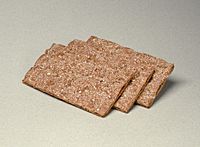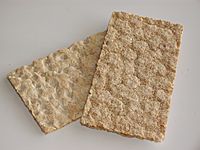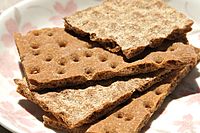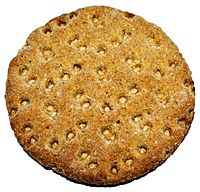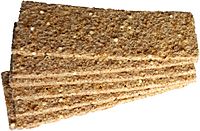Crispbread facts for kids
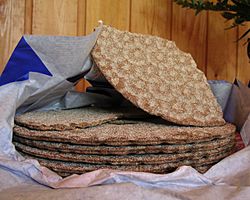
Some wafers of crispbread.
|
|
| Alternative names | Hard bread |
|---|---|
| Type | Cracker |
| Place of origin | Sweden |
| Region or state | Nordic countries |
| Main ingredients | Rye flour, salt, water |
Crispbread (also known as knäckebröd in Swedish) is a very thin, flat, and dry type of bread. It's a bit like a cracker! Most crispbread is made from rye flour. Because it has almost no water, crispbread is very light and stays fresh for a super long time. This makes it a great food to store. For many years, it was a basic food, especially for people who didn't have much money.
Contents
The History of Crispbread
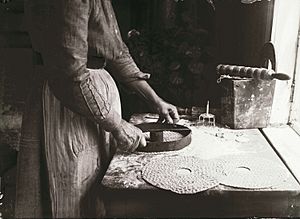
Crispbread has a long and interesting history. Countries like Finland and Sweden have been eating it for many centuries. The earliest type was called spisbröd, which means "stove bread." It was similar but thicker. People in central Sweden were baking these breads as far back as the 6th century. They would often hang them above the stove to dry them out.
Traditional crispbread in Sweden and western Finland is round and flat. It has a hole in the middle. This hole was useful for storing the bread on long poles. These poles would hang near the ceiling, keeping the bread safe and dry.
When Was Crispbread Baked?
In the past, crispbread was usually baked only twice a year. People would bake a big batch after the harvest season. They would bake another batch in the spring. This was when the frozen rivers started to melt and flow again.
The thinner crispbread we often see today first came from eastern Värmland, a region in Sweden. The very first factory to make crispbread was AU Bergmans enka. It started production in Stockholm, Sweden, in 1850. Rectangular crispbread, which is popular now, was first made in Germany in 1927. It has been a favorite there ever since.
Where is Crispbread Most Popular?
Crispbread is still very common in homes today. In 2003, studies showed that 85% of homes in Sweden had crispbread. In Germany, about 45% of homes had it. In France, only about 8% of homes kept crispbread.
What is Crispbread Made Of?
Crispbread is traditionally made with simple ingredients. These are usually wholemeal rye flour, salt, and water. However, many types of crispbread today have other ingredients. Some include wheat flour, different spices, or other grains.
How is Crispbread Made?
Sometimes, crispbread is made with yeast or sourdough. This makes it rise a little. You might also find crispbread with milk or sesame seeds added.
For crispbreads that don't use yeast, bubbles are put into the dough in other ways. Long ago, people would mix snow or powdered ice into the dough. This would create bubbles when it evaporated during baking. Today, the dough is cooled and mixed a lot until it gets bubbly.
Another way to make bubbles is using a special machine called an extruder. The dough is kneaded under high pressure. Then, the pressure is suddenly dropped. This makes the water in the dough turn into steam, creating bubbles.
Crispbread bakes very quickly. It only takes a few minutes. The ovens are usually very hot, between 200 and 250 degrees Celsius (390-480°F).
How to Eat Crispbread
Crispbread is very dry on its own. So, it's usually eaten with a spread. Butter is a common choice, and then you can add other toppings. Crispbread is often part of a daily meal.
Crispbread in School Meals
In Sweden and Finland, crispbread with butter or margarine is often served in school meals. It's a healthy and easy addition to lunch.
Other Ways to Enjoy Crispbread
You can also break crispbread into pieces. Then, you can add it to yogurt or a sour milk product called filmjölk. It's a bit like eating cereal or muesli. Some people even use crispbread as a base for pizza! In Sweden, crispbread is a common side dish for pea soup. It's also often served with pickled herring.
Gallery
Different types and shapes of commercial crispbread:
See also
 In Spanish: Knäckebröd para niños
In Spanish: Knäckebröd para niños


